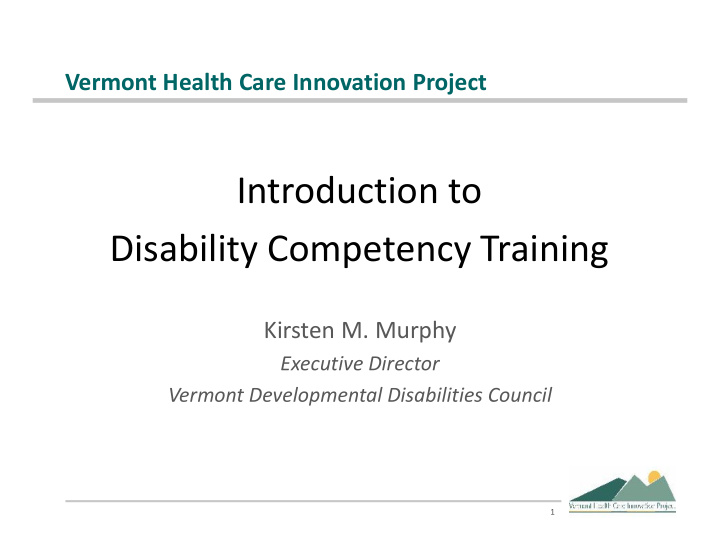



Vermont Health Care Innovation Project Introduction to Disability Competency Training Kirsten M. Murphy Executive Director Vermont Developmental Disabilities Council 1
Overview of our Training Team Four Vermont disability organizations with shared beliefs in …. � The central importance of individual and family voices � The need for advocacy at both the personal and at the systems level � Collaboration trumps difference 2
The Values of the Federal DD Act Self Determination Being your own boss. Independence Adventuring out on your own. 3
The Values of the Federal DD Act Self Determination Community Inclusion Being your own boss. I have a role to play. Independence Productivity Working hard Adventuring out on and achieving your own. your goals. 4
Three Stories A MEANINGFUL R OLE IN C OMMUNITY 5 5/29/2016
Activity: the social determinant of health Ableism Housing Health Insurance Clean Water Safe Neighborhood Food security Racism Language Barriers Asset Acquisition Access to healthy food Unequal pay for women Prejudice against… Employment Toxin free environment Transportation Immigration Status Education 6
Review: the social determinant of health Genes & Biology Social and Built 10% Environment Economic 10% 40% Clinical Care 10% Health Behaviors 30% 7
The Roseto Effect How a small Pennsylvania town enjoyed unexpected good health 8 5/29/2016
The Roseto Effect, cont. How can we explain rates of heart disease that were only half the national average? 9
The Guinea Pig Club East Grinstead, England “The Town that Didn’t Stare” 10
Lessons from Grinstead, Sussex, England For Video, See YouTube: “The Town that Didn’t Stare” https://www.youtube.com/watch?v=NfwP6vs6rCo First 4 minutes, 21 seconds 11
Lisa from Bennington, VT Finding community in Vermont 12
Why Introduce Care Managers to Disability? H EALTH D ISPARITIES & D ISABILITY 13
Disability is Common Prevalence of disability 2013: 22% of adults 1 in 5 or 53 million Americans Vermont prevalence: 17.8% 14 5/29/2016
Disability is Common , Cont. AGE RANGE OF PEOPLE WITH DISABILITIES Children 7% Ages 65+ Ages 40% 18-65 52% 15 5/29/2016
Disability leads to health disparities Health disparity : Differences in health and health care between population groups that reflect a longstanding history of unfair treatment and/or unequal access to resources . Examples Health Status Pattern of Utilization Access to Care Adherence to Treatment Experience of Care Mortality Rate 16
Disability and Health Disparities � Adults with disabilities are 4x more likely to report poor health status than adults without disabilities; � Adults with disabilities are at a 2.5x greater risk for developing chronic diseases; � 71% of adults over 40 with intellectual disabilities have at least 2 chronic diseases; 17 5/29/2016
Disability and Health Disparities , Cont. � Adults with intellectual disabilities are 6x more likely to be hospitalized than their peers; � The risk of developing mental illness or suicidal tendencies is 3x higher in adults with intellectual disabilities compared to adults without disabilities; � Students with disabilities are more likely to smoke cigarettes, use marijuana, or drink alcohol than students without disabilities. 18
Health Status On a team of 10 athletes . 6 are obese or overweight 4 have obvious tooth decay and 1 needs an urgent referral to a dentist 3 fail a hearing test 4 need glasses and 2 have an eye disease 5 have a significant problem with flexibility.
Health Status: Vermont’s 3 → 4 → 3 Health Behaviors that Contribute to 4 Chronic Disease that account for 50% of deaths 90% 80% 85% 79% 70% 60% 50% 51% 40% 42% 30% 29% 20% 18% 10% 0% Do NOT eat recommended fruits and Do NOT get recommended physical activity Currently smoke veggies All VT Adults VT Adults with Disabilities 20
Health Status 3 → 4 → 4 Chronic Diseases Chronic Disease Diagnosis All VT Adults All VT Adults with Disabilities Lung Disease (Asthma/COPD) 15% 28% Diabetes & Pre-Diabetes 13% 25% Cardiovascular Disease 7% 16% Cancer 7% 12% 21
Utilization: ED Visits by Adults with I/DD VT HSA Cohort 1 Cohort 2 Total Barre .57 1.80 .99 Cohort 1 People with Bennington 1.95 1.22 1.52 HCBS* Brattleboro .53 1.00 .79 N= 2719 Burlington .60 .78 .66 Middlebury .39 2.29 1.26 Morrisville .67 .62 .65 Cohort 2 People w/out Newport .38 1.45 .79 HCBS* Out of State .62 .96 .76 N= 1906 Randolph .56 .56 .56 Rutland .77 1.51 1.10 Average Springfield .87 1.54 1.21 Vermonter used St. Albans 1.13 1.41 1.26 ED .48 x/year St. Johnsbury .81 .92 .86 White River Jct. .61 1.11 .84 Total .74 1.27 .96 * HCBS = Home and Community Based Supports 22
Expense: ED Visits � ED use by Cohort 1, 38.8% non-emergent � ED use by Cohort 2, 44.0% non-emergent � Mean cost of ED visit, Cohort 1: $ 40.27 � Mean cost of ED visit, Cohort 2: $279.01 Almost 7x more
Beyond socio-economic factors… 24
Social Role Valorization H EALTH AND C OMMUNITY I NCLUSION 25 5/29/2016
Social Role Valorization JM, High School Athlete 26
Social Role Valorization 27
Social Role Valorization Lois Curtis, Artist 28
Review: The social determinant of health Ableism Housing Health Insurance Clean Water Safe Neighborhood Food security Racism Language Barriers Asset Acquisition Access to healthy food Unequal pay for women Prejudice against… Employment Toxin free environment Transportation Immigration Status Education 29
Final Thoughts Housing that is a Home Transportation because I have somewhere to go 30
Recommend
More recommend